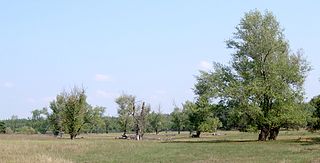
Crux is a constellation of the southern sky that is centred on four bright stars in a cross-shaped asterism commonly known as the Southern Cross. It lies on the southern end of the Milky Way's visible band. The name Crux is Latin for cross. Even though it is the smallest of all 88 modern constellations, Crux is among the most easily distinguished as its four main stars each have an apparent visual magnitude brighter than +2.8. It has attained a high level of cultural significance in many Southern Hemisphere states and nations.

A cross is a geometrical figure consisting of two intersecting lines or bars, usually perpendicular to each other. The lines usually run vertically and horizontally. A cross of oblique lines, in the shape of the Latin letter X, is termed a saltire in heraldic terminology.

The substantia nigra (SN) is a basal ganglia structure located in the midbrain that plays an important role in reward and movement. Substantia nigra is Latin for "black substance", reflecting the fact that parts of the substantia nigra appear darker than neighboring areas due to high levels of neuromelanin in dopaminergic neurons. Parkinson's disease is characterized by the loss of dopaminergic neurons in the substantia nigra pars compacta.

Pinus nigra, the Austrian pine or black pine, is a moderately variable species of pine, occurring across Southern Europe from the Iberian Peninsula to the eastern Mediterranean, on the Anatolian peninsula of Turkey, Corsica and Cyprus, as well as Crimea and in the high mountains of Northwest Africa.

CRUX is a lightweight x86-64 Linux distribution targeted at experienced Linux users and delivered by a tar.gz-based package system with BSD-style initscripts. It is not based on any other Linux distribution. It also utilizes a ports system to install and upgrade applications.

Populus nigra, the black poplar, is a species of cottonwood poplar, the type species of section Aigeiros of the genus Populus, native to Europe, southwest and central Asia, and northwest Africa.

Linea nigra, denoted by its Latin translation "black line," colloquially known as the pregnancy line, manifests as a linear area of heightened pigmentation frequently observed on the abdominal region during pregnancy. Typically spanning approximately one centimeter in width, this brownish streak extends vertically along the midline of the abdomen, spanning from the pubis to the umbilicus. Variably, it may traverse from the pubis to the upper abdominal region.

Crux Easton wind engine is a Grade II listed Titt wind engine, used as a windpump, at Crux Easton, Hampshire, England, which has been restored to working order.

Sternotomini is a tribe of longhorn beetles of the subfamily Lamiinae. It was described by Thomson in 1860.

Freadelpha is a genus of longhorn beetles of the subfamily Lamiinae, containing the following species:
Freadelpha chloroleuca is a species of beetle in the family Cerambycidae. It was described by Harold in 1879.
Freadelpha cinerea is a species of beetle in the family Cerambycidae. It was described by James Thomson in 1878.

Freadelpha eremita is a species of beetle in the family Cerambycidae. It was described by John O. Westwood in 1845, originally under the genus Lamia. It has a wide distribution in Africa.
Freadelpha principalis is a species of beetle in the family Cerambycidae. It was described by Dalman in 1817, originally under the genus Lamia. It has a wide distribution in Africa.
Freadelpha rex is a species of beetle in the family Cerambycidae. It was described by Karl Jordan in 1903.
Freadelpha amoena is a species of beetle in the family Cerambycidae. It was described by Westwood in 1841. It is known from the Republic of the Congo, the Democratic Republic of the Congo, and Ghana.
Freadelpha burgeoni is a species of beetle in the family Cerambycidae. It was described by Stephan von Breuning in 1935.
Freadelpha confluens is a species of beetle in the family Cerambycidae. It was described by Harold in 1879. It is known from Tanzania, the Democratic Republic of the Congo, Angola, and Zambia.
Freadelpha leucospila is a species of beetle in the family Cerambycidae. It was described by Karl Jordan, in 1903. It is known from the Republic of the Congo, the Democratic Republic of the Congo, and Equatorial Guinea.

Freadelpha polyspila is a species of beetle in the family Cerambycidae. It was described by Harold in 1879. It is known from the Democratic Republic of the Congo, Tanzania, Angola, Zambia, and Malawi.










